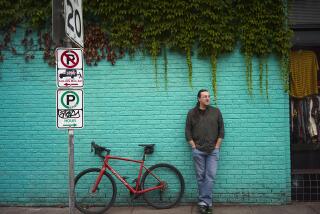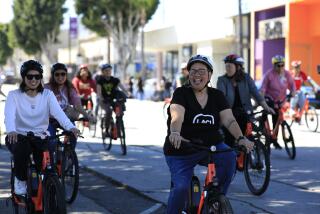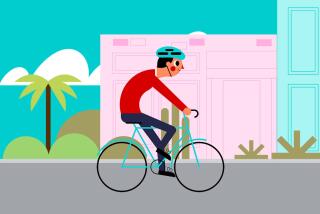Old and Tired : Bicycles From Golden Era Keep Collectors Young in Memories and Dreams
In the early decades of this century, a bike was a bike was a bike--no flash, just a strictly utilitarian means of getting around. Then, in 1934, something curious happened.
That something was the Schwinn Aerocycle, a bit of inspired fancy that dared to deviate from the cookie-cutter bicycle designs of the day with such fanciful extras as a fake gas tank on the cross bar, shaped like the cross section of an airplane wing.
The debut of the Aerocycle ushered in the bicycle’s age of excess. Bikes became industrial art, with the straight tubing of old replaced by gracefully curving steel. Gaudy was in, with wild paint schemes and red rubber tires, spring forks, headlights incorporated into the fenders and handlebar “dashboards” with built-in speedometers.
Then there were the model names: Motorbike, Auto Cycle, Colorflow, Super Streamliner, Monarch Silver King, Road Master.
“It’s a sculptural art form you can ride,” said collector Charlie Churchill, a teacher at a Garden Grove High School, whose passion is balloon-tire bikes of the pre-World War II era. For collectors, the years between 1934 and 1959 are the golden years of bicycle design, when form was valued over function.
Says Churchill: “That was a period of time when the point was, how lavish can we be?”
Finding a classic bike in near-original condition, carefully stored in someone’s garage, is the dream of every collector. But such finds are rare: Not only has time turned the metal to rust and the tires to dust in most cases, but young boys were likely to strip some of the fancy doodads off their bikes as soon as they got them home.
Part of that can be attributed to a youngster’s urge to customize, said Gary Hoisington, owner of Team Bicycle in Huntington Beach and a restorer of classic bikes. Also, particularly in the lean prewar years, there was pressure to make the bikes a little less showy .
“If you’re riding around on an $80 bike during the Depression, how much do you think kids are going to hate you?” Churchill asked.
*
The tendency to alter a bike was less prevalent in young girls than in young boys, Hoisington said, so girls’ bikes in good condition are easier to find--and thus less valued--than boys’ bikes. On the same model, for instance, the boys’ version in good original condition might sell for $1,500, while the girls’ style would fetch only $300.
One measure of the popularity of bike-collecting is attendance at bike-related swap meets. Hoisington held one recently that drew around 45 vendors (some selling parts, some selling complete bikes) and thousands of attendees, some of them simply curious but many of them serious collectors.
While pre-World War II bikes can be more of a collecting challenge, because of their greater age and because many were lost to wartime scrap metal drives, many collectors of baby boom age prefer the bikes of the ‘50s.
Of the thousands of bike models to come and go during the era, some are much more collectible than others. One of the most sought-after bikes, now as in its ‘50s heyday, is the Schwinn Black Phantom. Nostalgia lends the bike a two-pronged appeal to collectors today.
“If you had one, you’re reliving old memories,” Hoisington said. “If you didn’t, you’re finally attaining a dream.”
Hoisington has two Black Phantoms in his shop, one that he is restoring completely. “I’ve been collecting parts for 1 1/2 years,” he said. “I just got the $350 seat in stock to put on it.”
Gathering original parts for a complete restoration can be a lengthy and painstaking process. The tires on Hoisington’s Black Phantom, for instance, were purchased from another collector who had three sets of vintage tires that, somehow, had escaped the ‘50s unused. “As you can see, these have never hit the ground,” Hoisington said.
“This bike is now absolutely flawless,” he added. The tricky thing about collecting bikes is that Hoisington’s flawless restoration is worth less than a bike in flawed but good original condition.
A restored Black Phantom can sell for anywhere from $1,500 to $2,500, but one in good non-restored condition can sell for $3,500 and up. That’s because bikes that survived in original condition are rarer and more highly prized. The original baked-enamel finish can be kept without repainting with modern compounds, and the original chrome still shines with a bit of polish.
Therefore, if a bike is in nearly complete condition, it can be best to leave it pretty much as is. If the bike is missing parts or is heavily rusted, it can be “a good investment to go ahead and restore it,” Hoisington said.
And lest anyone think that the bikes are good only for museum showcases, “we have a lot of customers who do ride them,” Hoisington said.
Born in 1952, Hoisington came of age at the tail end of the balloon-tire cruiser age, but those are the bikes he fell in love with. “I like the balloon-tire bikes,” he said. “They were used bikes when I was a kid.”
He became a customer of one of the county’s first bike restorers, Larry McNeely, and eventually opened his own shop. Now Team Bicycle is a hub for classic bike collectors and enthusiasts, as are the Pedal Pusher in Newport Beach and Schwinn Plus in Tustin, other shops specializing in restoration.
Among the customers who dropped in to Team Bicycle recently were Churchill and Dean Butterfield, a collector who specializes in another era, pre-1900 bicycles. Churchill brought pictures of his latest acquisition, a vintage Aerocycle with its original red paint still gleaming and all its parts intact.
The owner had covered the paint with varnish and stored the bike away before going off to fight in World War II. When he returned, he held on to the bike but never rode it, leaving it in almost pristine condition.
As time passes, such stories become rarer and rarer for the old bikes. Meanwhile, some collectors are turning their attention to another category of bike, the banana-seat Schwinns of the ‘60s. As each age group grows up and becomes affluent, Hoisington explained, it becomes enamored with the things of its childhood.
Some 26-inch bikes of the decade are also collectible, such as Corvettes, Jaguars, Speedsters and Typhoons, but much of the attention falls on the smaller Sting-Rays, Fastbacks and Crates (Crate model names include the Pea-Picker, the Banana Peeler, the Apple Peeler and the Orange Crate).
Prices for a collectible bike in good condition can range from $250 to $800, with top dollar going to the most desirable of the lot, a Schwinn Gray Ghost in good condition.
These days, bike design again prizes utility above all else, with low weight and high speed the highest priorities. The old bikes were not as fast or as easy to ride, but they hold on to a different kind of charm for their aficionados.
“That’s industrial design in its highest form,” said Churchill, looking at a snapshot of his new Aerocycle.
Upcoming classic bike swap meets include the Whiz-In at Irvine Valley College on Aug. 1 (call (714) 996-6323 for information), and a meet in Huntington Beach on Aug. 22 (call Hoisington at (714) 969-5480 for information).





